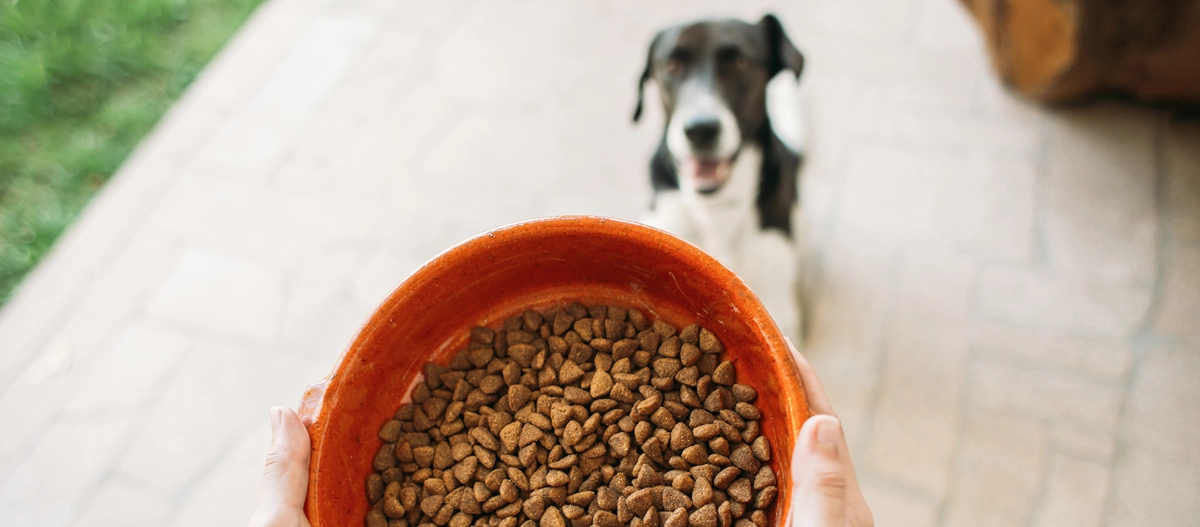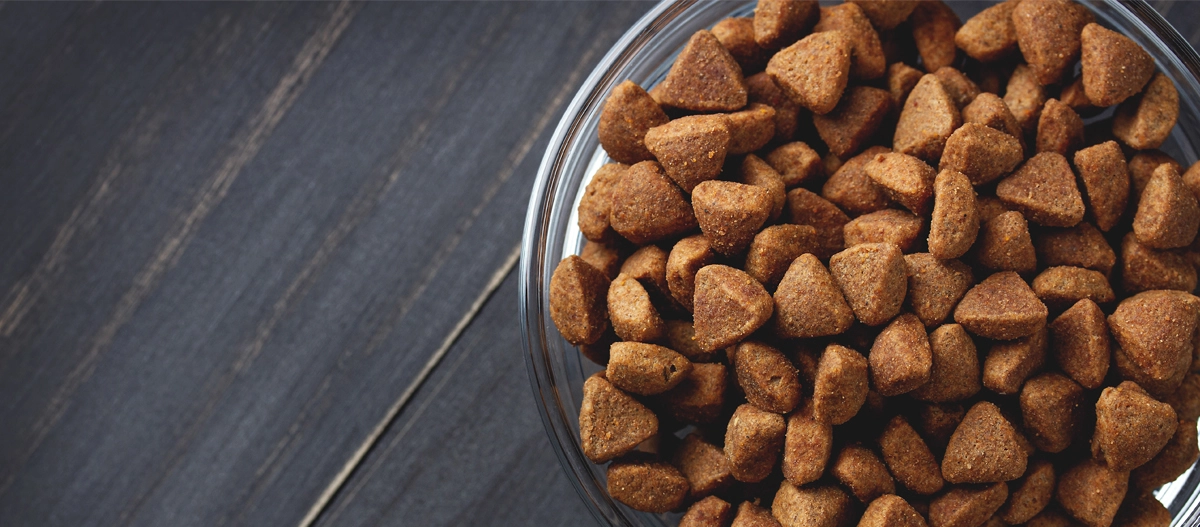In today’s world, there are numerous feeding options for dogs. Keeping track of them is a challenging task. Between terms like BARFing, dry and wet food, gluten-free, and protein-rich, it’s important to know how much food your furry friend truly needs. We have compiled useful information for you to realistically assess the feeding quantity for your dog and explained the relevant factors.
- How Much Food Does My Dog Need?
- The Food Quantity Depends on the Energy Needs
- Calculating Energy Needs: Here’s How!
- How High is the Requirement for Puppies and Older Dogs?
- Is My Dog Overweight or Underweight?
- Calculating Dog Food Amounts: Supplements
- Special considerations in dog food calculation
- Dog food calculator – feeding dry food
- Dog food calculator: Properly feeding wet food
- Dog Food Calculator – Cooking at Home and Proper Mixing
- Dog Food Calculator for BARFing
- Nutritional Counseling for Dogs
- Dog Food Calculator – Puppy Feeding
How Much Food Does My Dog Need?
First and foremost, it’s not possible to answer this question universally. The calculation of the correct food quantity for your dog is determined by a variety of factors. We guide you through the most important areas and explain what to consider when determining the portion size.
If you feed your dog ready-made food, it’s a good start to initially follow the package instructions. However, keep in mind that these are feeding recommendations, not precise “dosages” in grams, as with medications.
In general, when it comes to feeding, rely on your common sense. You know your dog best and live closely with them. Observe their figure, weight development, and well-being. This way, you can more easily assess whether you have determined the right amount of food. The following tips will help you with that.

The Food Quantity Depends on the Energy Needs
The amount of dog food that ends up in the bowl depends on your dog’s actual energy needs. The following questions are crucial for the calculation:
- How big/heavy is your dog?
- What breed does your dog belong to, or what is in your mixed-breed dog?
- Is your dog a good food processor?
- Does your dog get treats?
- Is your dog underweight or overweight?
- How much exercise does your dog get?
- Is your dog pregnant or nursing?
- Is your dog neutered?
- Does your dog have a metabolic disease?
When feeding your dog, it is essential to pay attention to a balanced ratio of proteins and energy. Adequate supply of vitamins and minerals is also fundamental for maintaining their health. While exact nutrient information is already provided on the packaging for complete pet foods, it is crucial, especially for individual feeds, to know the exact proportions.
Calculating Energy Needs: Here’s How!
There are online automatic feeding calculators that determine how much food your dog needs. With the following formula by Meyer and Zentek, you can easily determine the energy needs yourself. The result represents the maintenance energy requirement of an adult dog in megajoules.
Energy Requirement = 0.52 MJ x (Body Weight)kg^0.75 = MJ per day
Taking the example of a 25-kilogram adult dog, the calculation looks like this:
Energy Requirement = 0.52 MJ x 25kg^0.75 = 5.81 MJ per day
If you can’t visualize much in megajoules and want to compare it with calories, simply multiply your result by 239. So, our example dog with a body weight of 25kg needs approximately 1388 calories per day.
Tip: There are also formulas for calculating other nutritional requirements, such as your dog’s protein needs. Interested individuals can thus find out even more precisely what quantity and proportions of food their dog needs.

How High is the Requirement for Puppies and Older Dogs?
Puppies have increased energy and nutrient needs. To determine the energy requirement of your puppy, you need to differentiate between small and large dog breeds.
- Puppies of small dog breeds = 0.66 megajoules x body weight in kg^0.75
- Puppies of large breeds = 0.75 megajoules x body weight in kg^0.75
Regarding body weight, consider the current weight, not the target weight for the fully grown dog of the breed.
Older dogs also have different needs than young adult dogs. They require less energy intake, as they may not be as active and their metabolism generally consumes less energy. Remember to adjust the amount of food in this case as well.
If in doubt, consult your veterinarian, who can assist you with this. Read more about the age-appropriate nutrition of your dog in our guide.
Is My Dog Overweight or Underweight?
Most dogs these days are unfortunately too heavy and carry excess weight. This is not healthy as it puts a strain on metabolism, circulation, and joints.
You can tell if your dog has an ideal weight when the ribs and spine are just not individually visible. You should be able to feel them easily and without pressure. When looking down on your dog, the waist should be clearly visible – though there are breed-specific differences.
If your dog is underweight, ribs and spine are clearly visible.
If your dog likely has overweight, the waist is difficult to discern, and you may not feel or only slightly feel the ribs and spine when petting.
The best way to monitor your dog’s weight development is through regular weighing. Many veterinary practices have a suitable scale in the waiting room. For small dogs, you can simply take them in your arms and use your own body scale.
Tip: Remember that even small treats contain calories, so consider this when calculating the food amount for your beloved pet. Those who distribute many treats or involve the dog in their own meals should fill the dog’s bowl with significantly less.
Tip: In almost every pet store, there is a large scale in the entrance area. Take your dog with you and weigh them every time you shop. Especially for large dogs, this is the most uncomplicated way to determine weight.
Calculating Dog Food Amounts: Supplements
The dog food calculator allows you to calculate the energy needs. Protein and fat requirements can also be easily determined. However, it becomes more challenging when it comes to additional nutrients such as vitamins, minerals, trace elements, and dietary supplements to support your dog’s health. When dosing supplements for dogs, it is recommended to pay close attention to the recommendations on the packaging.
Popular dog supplements include vitamin and nutrient blends to strengthen immune defenses in winter, for skin and coat health, and for joints with mild arthritis. There are also high-quality dietary supplements for calming and smooth digestion, which can be fed in addition to the regular food.
Furthermore, there are special vitamin and mineral blends for dog owners who feed their dogs a BARF diet (Biologically Appropriate Raw Food) or cook for them.
Special considerations in dog food calculation
“Sensitive,” “gluten-free,” or “protein-rich” – more and more types of dog food have these special designations today. For most dogs, these specialty foods are not necessary. However, if you have a sensitive or sick dog, you should consider the available options.
“Sensitive” usually hides hypoallergenic types of food, which, for example, contain only one type of protein, i.e., one type of meat. Overall, the ingredient list for these foods is often much shorter than for other types of food. Pay attention to the energy content in the food calculation, as it may be lower.
“Gluten-free” food consists of types that do not contain gluten-containing grains such as wheat.
The protein content of “protein-rich” food is higher – which is good for working dogs. Puppies also need a lot of protein. However, be cautious with older dogs or those with kidney problems. Their protein requirements are lower.
Dog food calculator – feeding dry food
Many dog owners opt for dry food for daily feeding. Dry food is practical, durable, and easy to store. When dosing, you can simply follow the table on the packaging. This recommendation provides a certain dosage range based on your dog’s weight.
Dry food has a very high energy content per gram. Additionally, there are significant differences between the various dry food types. This means that you should review the recommendations when changing the type or brand.
Most dry food types have an energy content of about 350 to 380 calories per 100 grams of food. This means that our 25kg example dog can receive about 380-400 grams of such dry food per day.
Dog food calculator: Properly feeding wet food
Wet food contains large amounts of water, making it significantly different from dry food in terms of energy content. On average, 100 grams of wet food contain about 100 to 120 calories for most types. Therefore, our example dog with a weight of 25kg may eat between 800 and 1200 grams of wet food per day depending on the breed.
Tip: Do you normally feed wet food, and only switch to dry food when traveling because it’s more convenient? Then pay close attention to the quantity, as the amount in the bowl will be much less, which is why many dog owners are very generous when occasionally feeding dry food.
Dog Food Calculator – Cooking at Home and Proper Mixing
Are you completely avoiding commercial ready-made dog food and complete pet foods? Cooking for your dog and raw feeding, known as BARFing, have been trending strongly in recent years. It allows you to have complete control over what goes into your dog’s bowl every day. However, for you as a dog owner, cooking dog food or BARFing presents a special challenge: you must ensure that your dog receives everything he needs.
This involves both energy and nutrient intake. A well-balanced meal not only consists of meat but also needs to include organs, bones, vegetables, fruits, minerals, oils, and herbs. If desired, you can add carbohydrates for increased energy intake.
To make sure your dog gets everything he needs, it’s essential to use a high-quality vitamin and mineral mix designed for BARF and mix it into the food. This helps meet the nutritional requirements with substances that might be lacking in a raw diet.
Tip: If raw meat or cooking is too labor-intensive for you, consider using pure meat cans. These provide the meat portion of the dog’s meal, and you can supplement with vegetables, fruits, and oils to create your homemade food!
Dog Food Calculator for BARFing
Interested in BARFing but unsure how to calculate it? Our BARF information pages help you understand the basics. Most BARF concepts work with a meat-to-vegetable ratio of 70:30 or 80:20. This means that 70 to 80 percent of the meal consists of meat, and within that, 10 to 15 percent of the meat should be bones and organs.
The remaining 20 to 30 percent is covered by vegetables, fruits, and carbohydrates. Fruit makes up the smallest portion. You should cook vegetables because dogs find it challenging to break down the cellulose they contain. Suitable sources of carbohydrates are oat flakes, potatoes, and rice. Carbohydrates are only necessary if your dog has a particularly high energy requirement.
Your dog also needs high-quality oil. Salmon, flaxseed, and hemp oils contain many omega-3 fatty acids and are, therefore, highly recommended. Your dog needs about 0.3 grams per kilogram of body weight. For example, our 25kg example dog would require 25 kg x 0.3 grams = 7.5 grams of oil per day. This is approximately one teaspoon.
Tip: There are several BARF calculators available online. Consult specialized advisors and have a tailor-made recommendation created for your dog. BARFing gives you control over all the ingredients, making it an interesting alternative to ready-made food, especially for dogs with special needs or allergies.
Nutritional Counseling for Dogs
Have you followed all the recommendations, and yet your dog is still overweight? Or does your dog suffer from intolerances, manifesting in soft stool or skin problems? For owners of dogs with special dietary needs and anyone seeking optimal nutrition for their dog, nutritional counseling for dogs is recommended. It is offered by large veterinary practices, animal clinics, animal naturopaths, and specialized animal nutrition consultants. Check the qualifications and training of the counselor carefully, as the title of a dog nutrition counselor is not legally protected. Providers with a relevant background in veterinary medicine are recommended.
As part of the counseling, you will need to provide detailed information about the feeding. It’s best to keep a diary beforehand. Often, this can help identify connections between feeding and daily problems.
Dog Food Calculator – Puppy Feeding
Puppies grow rapidly and need the right nutrients during this time. In proportion to body weight, they require more food than adult dogs. While puppies need to be supplied with the necessary energy, they should not become overweight. Adjust the amount of food to meet the needs of your puppy during this time. The same applies to particularly active and pregnant/nursing females. In this article, you will find useful information on puppy nutrition.
Although the natural raw feeding method, known as BARFing, is trendy, it is not recommended as the sole feeding method for puppies or pregnant/nursing females. It requires a lot of experience and knowledge to recalculate the ration every two weeks and consistently provide everything necessary for the little canine. Veterinarians and dog nutrition experts, therefore, advise against self-cooking and BARFing in the first months.
If you wish, you can introduce the young ones to the first raw, meaty bones, or a partial BARF meal a day. It is important to adjust the overall ration of the main food accordingly.

Dog Food Calculator – Experience and Judgment
Despite all the calculations and recommendations, you should note that food and energy requirements are highly individual. What suits one dog may be too much or too little for another despite the same size and weight. The most important recommendation is: Feed by judgment and pay attention to your dog’s figure! You can directly see whether too much or too little is going into the bowl.


